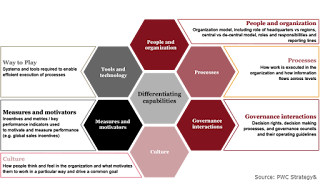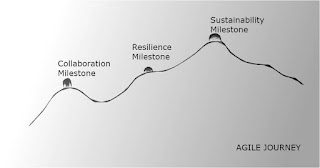Leadership in Agile Organizations
To many, leadership in organizations is associated with position, role, hierarchy, and the task-authority relationships vested in them. This is the traditional view and where are statutory, regulatory and governance requirements this view holds true even in organizations that have transitioned to Agile.
Hierarchical organizations took a matrix organization structure to deal with differing line and function management requirements, typical of projects.
As hierarchies flattened and the need to collaborate outside of functional silos became imperative, network organization structures evolved. However, most of these retained their bureaucratic hierarchical nature with frequent turf wars.
True network organization structures are dynamic in that they are in a constant state of flux. A network organization is a result of a transformation that is necessarily enterprise wide. The nature of leadership in a true network organization is diffused, very different from traditional hierarchies where it is concentrated in higher nodes.
We will attempt here, to unpack the fundamental needs of leadership in a network organization and derive a vision for guiding such transformations.
The agile movement started with the need to reduce bureaucracy and mindless documentation, placing focus on outcomes and the power to deliver those in the hands of those who actually executed the work. It was a way to prevent backloading risk and have this distributed across project timelines in manageable packets.
The reality is that, in organizations that have transitioned to Agile, the bureaucracy is substantially reduced, but never eliminated. There are numerous reasons for this, most of all, for accountability. Therefore, the end result of an agile transition is a dual structure - part hierarchical bureaucracy, part dynamic network - the dual operating system.
In the dual operating system, the hierarchy retains all accountability while the network is designed to maximize creativity and value delivery as well as the organizations' ability to adapt to change.
Agility is, therefore, an attribute of the network element. The hierarchy is merely sensitive to the needs of the dynamic agile network and acts as a friend and facilitator, guiding creative energy, arbitrating disputes, providing financial rigor, evaluating proposals and determining which to fund and what to shelve. The CEO, COO, CIO, finance & accounting, as well as most of the HR and support functions remain part of the hierarchy. Leadership here is as it is understood in the traditional sense.
So what kind of leadership is needed in the network element?
Essentially, the network recognizes leadership as an activity, vis-a-vis, as a position or designation. The best analogy for leadership in the network is derived from closed loop Control Systems Theory and is best represented by the Sensor-Actuator-Controller concept.
The system in steady state is disturbed by an external influence or perturbation which varies System Output. This variation is measured by the sensor which compares it with threshold reference parameters and if outside bounds, sends the measured error to the Controller which activates the Actuator allowing the System to respond appropriately.
In event-triggered control, sensing, communication, and action happens only when any predefined event condition is violated. Event-triggered system is modeled as a perturbed system, which is activated by an external disturbance or perturbation and is the architecture for event based adaptive control, a trained response that deals with volatility and uncertainty in the environment.
So how does this translate to the Agile Network?
Quite obviously, the System referred to here is the organization. The sensor, actuator and controller are model leadership roles assigned to ALL members of the network. The prime drivers are (a) initiative and (b) responsibility delegated by the bureaucracy element.
So how does a team member play out these roles?
The Sensor role is ubiquitous and is an environment scanner, sensitive to "disturbance" or external perturbation or event. The Sensor "measures" the impact of the disturbance on the system on a predefined scale and checks it against the tolerances (the Reference) set by the bureaucracy. If outside the defined threshold, it pushes [a pre-defined description of] the event into an organization-wide event queue where it is periodically assessed by one or more designated "away teams" or panels (Controller) to determine validity, risk impact and response. Once the response is determined (and this may take a while based on the complexity of the event and on the need for specialists), another "away team" is constituted and activated. All the while, the teams keep the designated bureaucracy element (Actuator) informed for potential organizational changes and for funding.
This is just one scenario. In reality, each member of the organization can play the role of Sensor, Controller, Actuator based on nature of the event (Disturbance), delegated authority and/or competence.
In essence, ANYONE in the organization can potentially "take the lead" to deal with the disturbance or event. There is only one analogy for this - in an ideal world, the end goal of leadership in Agile organization is to build capacity to achieve a "murmuration".
Hierarchical organizations took a matrix organization structure to deal with differing line and function management requirements, typical of projects.
As hierarchies flattened and the need to collaborate outside of functional silos became imperative, network organization structures evolved. However, most of these retained their bureaucratic hierarchical nature with frequent turf wars.
True network organization structures are dynamic in that they are in a constant state of flux. A network organization is a result of a transformation that is necessarily enterprise wide. The nature of leadership in a true network organization is diffused, very different from traditional hierarchies where it is concentrated in higher nodes.
We will attempt here, to unpack the fundamental needs of leadership in a network organization and derive a vision for guiding such transformations.
The agile movement started with the need to reduce bureaucracy and mindless documentation, placing focus on outcomes and the power to deliver those in the hands of those who actually executed the work. It was a way to prevent backloading risk and have this distributed across project timelines in manageable packets.
The reality is that, in organizations that have transitioned to Agile, the bureaucracy is substantially reduced, but never eliminated. There are numerous reasons for this, most of all, for accountability. Therefore, the end result of an agile transition is a dual structure - part hierarchical bureaucracy, part dynamic network - the dual operating system.
In the dual operating system, the hierarchy retains all accountability while the network is designed to maximize creativity and value delivery as well as the organizations' ability to adapt to change.
Agility is, therefore, an attribute of the network element. The hierarchy is merely sensitive to the needs of the dynamic agile network and acts as a friend and facilitator, guiding creative energy, arbitrating disputes, providing financial rigor, evaluating proposals and determining which to fund and what to shelve. The CEO, COO, CIO, finance & accounting, as well as most of the HR and support functions remain part of the hierarchy. Leadership here is as it is understood in the traditional sense.
So what kind of leadership is needed in the network element?
Essentially, the network recognizes leadership as an activity, vis-a-vis, as a position or designation. The best analogy for leadership in the network is derived from closed loop Control Systems Theory and is best represented by the Sensor-Actuator-Controller concept.
The system in steady state is disturbed by an external influence or perturbation which varies System Output. This variation is measured by the sensor which compares it with threshold reference parameters and if outside bounds, sends the measured error to the Controller which activates the Actuator allowing the System to respond appropriately.
In event-triggered control, sensing, communication, and action happens only when any predefined event condition is violated. Event-triggered system is modeled as a perturbed system, which is activated by an external disturbance or perturbation and is the architecture for event based adaptive control, a trained response that deals with volatility and uncertainty in the environment.
So how does this translate to the Agile Network?
Quite obviously, the System referred to here is the organization. The sensor, actuator and controller are model leadership roles assigned to ALL members of the network. The prime drivers are (a) initiative and (b) responsibility delegated by the bureaucracy element.
So how does a team member play out these roles?
The Sensor role is ubiquitous and is an environment scanner, sensitive to "disturbance" or external perturbation or event. The Sensor "measures" the impact of the disturbance on the system on a predefined scale and checks it against the tolerances (the Reference) set by the bureaucracy. If outside the defined threshold, it pushes [a pre-defined description of] the event into an organization-wide event queue where it is periodically assessed by one or more designated "away teams" or panels (Controller) to determine validity, risk impact and response. Once the response is determined (and this may take a while based on the complexity of the event and on the need for specialists), another "away team" is constituted and activated. All the while, the teams keep the designated bureaucracy element (Actuator) informed for potential organizational changes and for funding.
This is just one scenario. In reality, each member of the organization can play the role of Sensor, Controller, Actuator based on nature of the event (Disturbance), delegated authority and/or competence.
In essence, ANYONE in the organization can potentially "take the lead" to deal with the disturbance or event. There is only one analogy for this - in an ideal world, the end goal of leadership in Agile organization is to build capacity to achieve a "murmuration".








Comments
Post a Comment